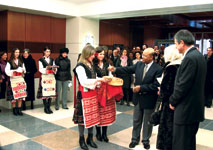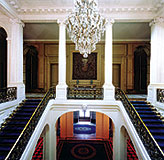...was key to securing the financial resources to grow the program, says one former associate. "This wasnt just lip service, he was leading it and making it happen," says the associate.
Such leaders generally find opposition within the organization they are trying to change, and Williams was no exception. "Some people dont like change [and Williams] represents change," says a source. The primary opposition came from architects who initially opposed the standard design concept. But while SED standardizes space parameters, perimeter facilities, utilities, building mass and structural grid, it still leaves room for architectural creativity.
"There is a lot of variation based on climate, topography, culture and locally available materials, and State encourages that," adds Rod Henderer, senior vice president in the Washington, D.C., office of architect RTKL. The firm was on the design-build team that built the completed embassy in Kampala, Uganda, which was used as a "springboard" for the SED, he says.
Achieving Buy-In
Williams also achieved buy-in from industry by launching an Industry Advisory Panel. The panel has nine members representing a wide variety of industry associations. Beijing Project Director Bagchi says the panel gives Williams a "sanity check" on how new ideas will impact construction.
At the panels April meeting, for example, Williams asked for ideas to keep designers and construction managers on the same page. Ida Brooker, manager of construction contracts for The Boeing Co., Seattle, said, "It doesnt matter if the two...are on the same page, if its the wrong page." She recommended starting a project with a work group that combines users, designers and contractors.
 |  |
| Sanity Check. Advisory panel members such as Tod Rittenhouse (l) and Ida Brooker keep OBO in tune with industry. (Photos courtesy of Department of State) | |
Panel member Tod Rittenhouse, principal of Weidlinger Associates, New York City, added that designers sometimes feel they are brought in to give the client "something different." He recommended a "project confirmation meeting," which clarifies objectives and says "this is the area where you can play, this is the area where you cannot play."
Williams has strived to bring new players into the embassy construction program which historically handed out work to the same few firms. Now, Industry Day lays out program plans to potential participants. It drew 450 attendees in 2003, almost 700 in 2004 and expects up to 900 at a meeting on Nov. 2.
One new player, HNTB, is drawn to the work largely because of the size of the market, estimated between $1 billion and $1.5 billion annually over the next 10 years. Embassy work is one of six focus sectors of HNTB Federal Services, says Kevin McDonald, president of the unit.
But traditional players also have stayed on board. Kirby Caddell, CEO of Caddell Construction Co. Inc., Birmingham, Ala., says his firm has been building embassies since the early 1990s. It is now working on the U.S. embassy compound in Beijing as well as seven other projects, including four in West Africa. Working in poor countries, requires enormous planning, Caddell says. "If we want a crane, an air compressor or a dump truck, we have to bring it in. We also have to bring in skilled workers."
 |
| Customs. Openings, such as this one in Sofia, Bulgaria, and designs involve local customs and materials. (Photo courtesy of Department of State) |
Success is defined by results, tracked by Williams monthly reviews. They are exhausting, participants claim. This discipline causes "all the people in the management chain to be accountable," says one. "Williams can be an extremely tough and demanding manager," says another former associate. "He also gets more results than anyone else Ive ever worked for."
Contractors agree. "He is a tough cookie," claims Paul Miles, president of Morrison International Construction Inc., Kennewick, Wash., which partnered on an office annex for the Albania embassy. "If he says 20 months, he means 20 months. He is relentless. When you make a commitment to OBO, you make a personal commitment to the general. He is watching you like a hawk. And that is not a bad thing."
| Embassy Interiors Reflect Countries As the embassy construction team focuses on architectural and engineering components, another team of designers on the same project is deciding how best to showcase the United States through the furnishings, art and ceremonial objects used by U.S. representatives in their official duties.
Embassy interiors often reflect the U.S. ambassadors style and personal taste. New ambassadors meet with the State Dept.s extensive interior decorating staff to select fabrics, furniture, carpets and drapery. For new compounds, the designers also work with architects to highlight certain design elements. The host countrys climate and culture are taken into consideration when creating the interior. Ceremonial china, crystal and silver is standard worldwide in every U.S. embassy. The seal on each glass and the design on every plate signifies the type of event and who is in attendance. If the ambassador is presiding, china and crystal with a specific seal is used. If the deputy chief of mission is most senior, a different pattern is used. The State Dept.s Art in Embassies program provides paintings, sculpture and other media, loaned by artists or institutions, for display in the official residence, says Robert T. Soppelsa, a program curator. This "diplomatic outreach program" can highlight social issues or personal preferences. One ambassadors love of rodeos was reflected in the art he selected. |
|
Southern Upbringing, Military Training Influence Williams Management Style Charles E. Williams says he has never had an easy job. "Every single job I have ever had, has been a tough, tough job," says the former Army Corps of Engineers official, who retired in 1989 as a major general.
Williams joined the Corps after college in 1960, beginning a career that included a stint as a helicopter pilot in Vietnam, flying engineers while under enemy fire to sites to repair roads. As a captain, Williams met another Army captain also destined for a distinguished career: Colin Powell. Both were stationed in Germany in the early 1980s, and they remained in touch. Williams capped his 29-year Corps career as head of the high-profile North Atlantic Division. His duties included program manager for the rebuilding of Fort Drum, N.Y., the largest Army troop construction project since World War II (ENR 6/4/87 p. 13). When Williams retired from the Corps, he took on the New York City public school building program, serving as president of the citys School Construction Authority. With a $4.3-billion budget, it was the largest such program in the country. His next career move sent him to Virginia, where Williams became chief operating officer of Toll Road Investors Partnership. He was responsible for managing... |



Post a comment to this article
Report Abusive Comment